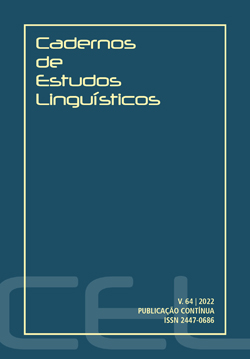Abstract
This study analyzes bem (well) in its use as a manner adverb when modifying verb phrases in Brazilian Portuguese. Taking the perspective that verb phrases can be broken down into a syntactically represented event structure, we argue that the manner adverb bem semantically selects durative sub-events (states or processes) and will always be allowed in verb phrases which have some durative component in their event structure. At the end, we show how this perspective even explains the occurrences of the adverb under analysis in verb phrases headed by verbs typically classified as achievements. This study therefore provides not only a robust description of the properties of bem as a manner adverb, but also an argument in favor of treating the structure of the verb phrase not as a syntactic structure projected by an item, but as a syntactic and semantic arrangement into which a verb root may be allowed.
References
ALEXIADOU, Artemis; ANAGNOSTOPOULOU, Elena. Structural Analysis of Unaccusatives. The unaccusativity puzzle: Explorations of the syntax-lexicon interface, v. 5, p. 114, 2004.
BORER, Hagit (2005). The normal course of events. Oxford University Press, Oxford
CASTROVIEJO, Elena; GEHRKE, Berit. A good intensifier. In: JSAI International Symposium on Artificial Intelligence. Springer, Berlin, Heidelberg, 2014. p. 114-129.
CHOMSKY, Noam. The minimalist program. MIT press,1995.
CHOMSKY, Noam. The minimalist program. MIT press, 2015.
CHOMSKY, Noam. 2001. Derivation by phase. In Ken Hale: A Life in Language, ed. Michael Kenstowicz, 1–52. Cambridge, MA: MIT Press.
CINQUE, Guglielmo. Adverbials na Funcional Heads: a cross-linguistic perspective. New York: Oxford University Press. 1999.
CINQUE, Guglielmo. Restructuring and functional heads: the cartography of syntactic structures volume 4. Oxford University Press on Demand, 2006.
CORVER, Norbert. Evidence for DegP. In: North East Linguistics Society. 1991. p. 4.
ERNST, Thomas. Modification of stative predicates. Language, v. 92, n. 2, p. 237-274, 2016.
FLEISCHHAUER, Jens. Degree gradation of verbs. Vol. 2. Düsseldorf University Press, 2016.
GEHRKE, Berit; CASTROVIEJO, Elena. Good manners: On the degree effect of good events. In: Proceedings of Sinn und Bedeutung. 2016. p. 252-269.
GOMES, Ana Paula Quadros; MENDES, Luciana Sanchez. Degree modification in Brazilian Portuguese and in Karitiana. ReVEL, edição especial n. 9, 2015. [www.revel.inf.br]
HALLE, M.; MARANTZ, A. “Distributed Morphology and the Pieces of Inflection”. In: HALE, K.; KEYSER, S. J. (Orgs.). The View From Building Twenty. Cambridge, Mass.: The MIT Press, 1993. p. 110-176.
KATZ, G. (2003). Event arguments, adverb selection, and the Stative Adverb Gap. In E. Lang, C. Maienborn, and C. Fabricius-Hansen (Eds.), Modifying Adjuncts, pp. 455–474. Berlin: de Gruyter.
KENNEDY, Chris. The syntax and semantics of gradability and comparison. University of California, Santa Cruz dissertation, 1997.
KENNEDY, Christopher; MCNALLY, Louise. Scale structure, degree modification, and the semantics of gradable predicates. Language, p. 345-381, 2005.
KRATZER, Angelika. Severing the external argument from its verb. In: Phrase structure and the lexicon. Springer, Dordrecht, 1996. p. 109-137.
KRATZER, Angelika. Building statives. In: Annual Meeting of the Berkeley Linguistics Society. 2000. p. 385-399.
KRATZER, Angelika. Building resultatives. In: Event arguments: Foundations and applications. Max Niemeyer Verlag, 2011. p. 177-212.
LARSON, R. 1998. Events and modification in nominals. In Proceedings from Semantics and Linguistic Theory (SALT) VIII, ed. D. Strolovitch and A. Lawson, 145–168. Ithaca, NY: CLC Publications, Cornell University.
MCNALLY, Louise; KENNEDY, Christopher. Degree vs. manner well: A case study in selective binding. In: Advances in generative lexicon theory. Springer, Dordrecht, 2013. p. 247-262.
MAIENBORN, C. (2005). On the limits of the Davidsonian approach: The case of copula sentences. Theoretical Linguistics 31.3, 275–316.
MAIENBORN, C.: 2004 (Ms., forthcoming), On Davidsonian and Kimian states, in I. Comorowski & K. v. Heusinger (eds), Existence: Semantics and Syntax. Berlin: Springer.
MAIENBORN, C.: 2005, On the Limits of the Davidsonian Approach: The Case of Copula Sentences (Target Article), Theoretical Linguistics 31-3, 275-316
MARANTZ, Alec. “No Escape from Syntax: Don’t Try Morphological Analysis in the Privacy of Your Own Lexicon”. University of Pennsylvania Working Papers in Linguistics, v. 4, n. 2, 1997.
MARANTZ, Alec. Words. Manuscrito, 2001.
MARANTZ, Alec. Argument structure and morphology: noun phrases that name events. Hand-out, New York University, 2006.
MARANTZ, Alec. Restitutive re-and the first phase syntax/semantics of the VP. University of Maryland, 2007.
MARANTZ, Alec. Verbal argument structure: Events and participants. Lingua, v. 130, p. 152-168, 2013.
MCNALLY, L.; C. KENNEDY (2013). Degree vs. manner well: A case study in selective binding. In J. Pustejovsky, P. Bouillon, H. Isahara, K. Kanzaki, and C. Lee (Eds.), Advances in Generative Lexicon Theory, Text, Speech and Language Technology, vol. 46, pp. 247–262. Dordrecht: Springer.
MEDEIROS, A. B. Prefixos, recursividade e a estrutura do sintagma verbal. Revista do GEL, v. 13, n. 1, p. 56-86, 2016.
MEDEIROS, A. B. Considerações sobre a estrutura argumental dos verbos. In: MEDEIROS, A. B.; NEVINS, A. (Orgs.). O apelo das árvores: estudos em homenagem a Miriam Lemle. São Paulo: Pontes, p. 231-298, 2018.
MITTWOCH, A. (2005). Do states have a Davidsonian argument? Some empirical considerations. In C. Maienborn and A. W¨ollstein (Eds.), Event Arguments: Foundations and Applications, pp.69–88. T¨ubingen: Niemeyer.
PARSONS, Terence. Events in the semantics of English: A study in subatomic semantics. 1990.
PYLKKÄNEN, L. Introducing Arguments. Tese (Doutorado em Linguística) – MIT, Cambridge MIT Press, 2002.
PYLKKÄNEN, L. (2008). Introducing arguments (Vol. 49). MIT press.
RAMCHAND, Gillian. Verb meaning and the lexicon: A first-phase syntax. Cambridge: Cambridge University Press, 2008.
TESCARI NETO, A. Sintaxe Gerativa: uma introdução à cartografia sintática. Campinas: Editora da Unicamp, 2022.
ZAMPARELLI, Roberto. Layers in the determiner phrase. 1995. Tese de Doutorado. University of Rochester.

This work is licensed under a Creative Commons Attribution-NonCommercial 4.0 International License.
Copyright (c) 2022 Cadernos de Estudos Linguísticos


